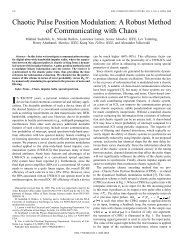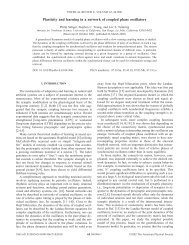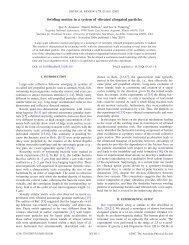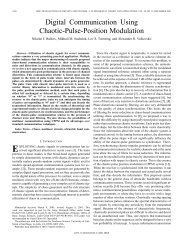A fast, robust and tunable synthetic gene oscillator - The BioCircuits ...
A fast, robust and tunable synthetic gene oscillator - The BioCircuits ...
A fast, robust and tunable synthetic gene oscillator - The BioCircuits ...
Create successful ePaper yourself
Turn your PDF publications into a flip-book with our unique Google optimized e-Paper software.
doi: 10.1038/nature07389<br />
Supplementary Information<br />
A <strong>fast</strong>, <strong>robust</strong> <strong>and</strong> <strong>tunable</strong> <strong>synthetic</strong> <strong>gene</strong> <strong>oscillator</strong><br />
Jesse Stricker 1⋆ , Scott Cookson 1⋆ , Matthew R. Bennett 1,2⋆ ,<br />
William H. Mather 1 , Lev S. Tsimring 2 & Jeff Hasty 1,2,3<br />
1 Department of Bioengineering, University of California, San Diego, La Jolla, California, 92093 USA.<br />
2 Institute for Nonlinear Science, University of California, San Diego, La Jolla, California, 92093 USA.<br />
3 Corresponding Author. Department of Bioengineering, University of California, San Diego, Mailcode<br />
0412, La Jolla, CA 92093-0412, USA. Telephone: 858 822 3442. Fax: 858 534 5722. Email:<br />
hasty@bioeng.ucsd.edu.<br />
⋆ <strong>The</strong>se authors contributed equally to this work.<br />
Materials <strong>and</strong> Methods<br />
Plasmid construction<br />
Using a tagging vector, the two components of the <strong>oscillator</strong> (araC <strong>and</strong> lacI) <strong>and</strong> the <strong>gene</strong> encoding<br />
the fluorescent reporter protein (yemGFP) were tagged with carboxy-terminal ssrA tags<br />
(Andersen et al. 1998) consisting of TSAANDENYALAA. <strong>The</strong> TS sequence encodes a SpeI site<br />
<strong>and</strong> acts as a linker, while the ssrA tag (in bold) targets proteins to the ClpXP degradation pathway,<br />
greatly increasing their degradation rates <strong>and</strong> therefore dynamic behavior. <strong>The</strong> first codon<br />
of the lacI <strong>gene</strong> was changed from its wildtype sequence of GTG to a st<strong>and</strong>ard ATG start codon.<br />
<strong>The</strong> GFP allele used in this study contains F64L/S65T/A206K mutations <strong>and</strong> is codon-optimized<br />
for yeast expression (Sheff <strong>and</strong> Thorn 2004). <strong>The</strong> first two mutations correspond to mut1GFP<br />
(Cormack et al. 1996), while the A206K mutation interferes with GFP dimerization (Zacharias<br />
et al. 2002). <strong>The</strong> yeast codon optimization does not appear to have any effects in E. coli other than<br />
a mild decrease in expression. In our experience, many GFP variants have deleterious effects in<br />
bacteria, especially when expressed at high levels, which may be due to multimerization (Shaner<br />
et al. 2005). <strong>The</strong> A206K mutation allows increased GFP expression without deleterious effects (as<br />
measured by growth rate or forward scatter measurements by flow cytometry).<br />
<strong>The</strong>se three tagged <strong>gene</strong>s were cloned into pZ modular plasmids under the transcriptional<br />
control of the p lac/ara-1 hybrid promoter (Lutz <strong>and</strong> Bujard 1997) to form three coregulated transcriptional<br />
modules. <strong>The</strong> promoter, ribosome binding sequence, <strong>and</strong> downstream terminator<br />
are identical between modules. <strong>The</strong> p lac/ara-1 promoter is activated by AraC in the presence of<br />
arabinose <strong>and</strong> repressed by LacI in the absence of IPTG. It includes two lacO operator sites, one<br />
overlapping <strong>and</strong> the other ∼500 bp upstream of the transcription start site. LacI repression is<br />
www.nature.com/nature<br />
1<br />
SUPPLEMENTARY INFORMATION







